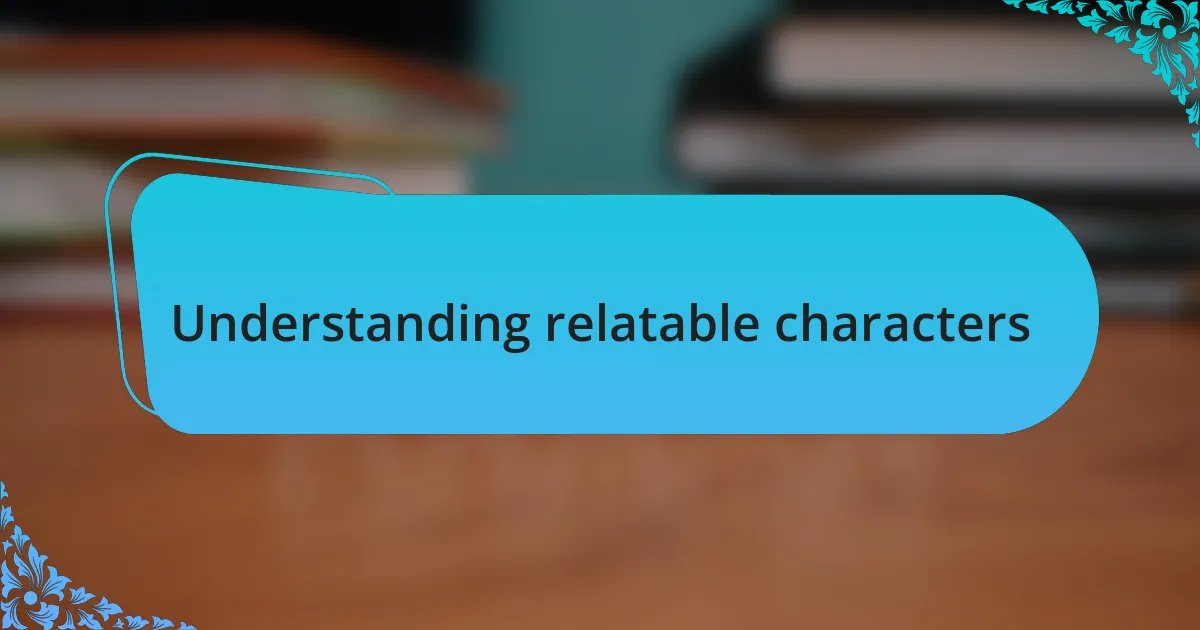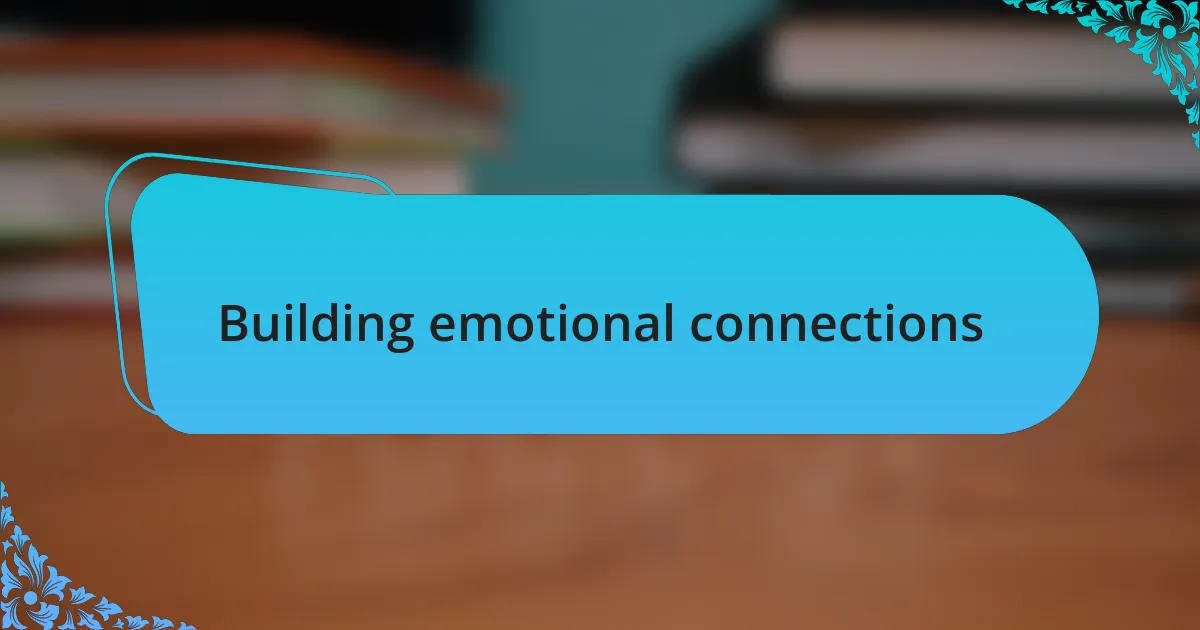Key takeaways:
- Relatable characters often reflect our own experiences, helping readers process emotions and develop empathy.
- Character development techniques include creating flaws, strong backstories, and natural dialogue to enhance relatability.
- Observing real-life interactions and sharing personal experiences can inspire authentic, layered characters.
- Engaging character stories resonate through shared vulnerabilities, emotional connections, and the use of humor to foster audience engagement.

Understanding relatable characters
Understanding relatable characters begins with acknowledging our shared human experiences. For instance, I often find myself connecting with characters who face dilemmas that mirror my own struggles, like balancing ambition with personal relationships. Doesn’t it hit differently when a character questions their choices, prompting us to reflect on our own paths?
I remember a novel where the protagonist grappled with loss and uncertainty, emotions that resonated deeply with me during a tough time in my life. This connection made the character feel like a friend, someone who understood my grief. I believe characters that evoke these feelings not only draw readers in but also allow us to process our emotions in a safe space.
To truly understand relatable characters, we must look for the layers beneath their actions. What drives them? What fears haunt them? When I create characters, I delve into their backstories, asking myself how their past shapes their decisions. This not only adds depth but invites the reader to empathize with their journey—an essential element for relatability.

Importance of character relatability
Characters that resonate with us often serve as mirrors reflecting our own feelings and experiences. I remember reading a story about a character who wrestled with self-doubt while pursuing their dreams. It struck a chord with me because, at one point, I faced a similar crossroads in my career. Seeing that struggle unfold on the page made me feel less alone in my journey.
Relatable characters can act as a guide during moments of turmoil. When I encounter a fictional character navigating heartbreak, I can’t help but relive my own past experiences with loss. It’s therapeutic, allowing me to feel validated in my emotions. The heartfelt connection to such characters deepens the reading experience, as if we have shared a bond that transcends the text.
Furthermore, relatability fosters empathy and understanding among readers. When characters confront their flaws, their mistakes become lessons for us. Have you ever read about a character who made choices you didn’t agree with, only to realize it mirrored a decision you once made? Such moments remind us that imperfection is part of the human experience—unpacking these narratives helps us understand both the characters and ourselves better.

Techniques for character development
To create relatable characters, I often start by giving them flaws and vulnerabilities that mirror real-life struggles. For instance, I have a character who battles anxiety while trying to fit into a new workplace. When I wrote about their internal monologue filled with self-doubt, it reminded me of my first day at a challenging job—those feelings were so familiar, and I believe many readers will connect with such honest portrayals.
Another technique I find effective is developing a solid backstory for each character. I recall crafting a character who had a tough upbringing but emerged resilient and determined. This development isn’t just for the sake of the plot; it gives the character depth and shows how their past influences their present. Have you ever wondered how a character’s childhood could affect their choices later? Those layers make them feel more authentic.
I also try to incorporate relatable dialogue that sounds natural and reflects real conversations. Once, I wrote a scene where two friends share their differing views on relationships, and their banter took me back to candid discussions with my own friends. These exchanges not only bring the characters to life but also allow readers to see themselves in those interactions, reinforcing the bond between fiction and reality.

Observing real-life inspirations
I find that real-life inspirations can come from the most unexpected places. There was a time I was waiting for a bus and overheard a couple arguing about something trivial. The intensity of their emotions struck me; it made me think about how people often argue over small issues when there’s something larger at play. Capturing that complexity in a character’s relationship can make their struggles resonate deeply with the audience.
Another instance that sparked inspiration for me was during a family gathering. Watching my grandmother interact with my cousins gave me insight into how different generations perceive the world. I realized that age brings wisdom, but it doesn’t shield one from pain or regret. This perspective helped me develop a character who, despite their age, grapples with the loneliness of unfulfilled dreams. Have you ever noticed how someone’s life story can hold a mirror to your own experiences? This connection elevates characters from mere fiction to representations of our collective human experience.
I often find that observing people in everyday situations can lead to unforgettable characters. Once, at a coffee shop, I met a barista who poured her heart into creating the perfect latte but struggled with her own insecurities. Listening to her talk about her passion made me realize how someone’s dedication can shine through their struggles, prompting me to create a character whose talent is overshadowed by their self-doubt. Isn’t it fascinating how the traits we admire in others often reflect our own battles? Drawing from these experiences helps craft relatable figures that readers embrace as part of their lives.

Building emotional connections
Building emotional connections requires an authentic touch; it’s about weaving in the nuances that make characters feel real. I remember a moment during a quiet evening stroll when I stumbled upon a friend sitting alone on a park bench, tears streaming down her face. The weight of unspoken burdens can be a powerful catalyst for character development. I realized that portraying a character’s vulnerability, akin to my friend’s raw expression of sorrow, allows readers to empathize deeply, fostering genuine emotional ties.
One memorable experience revolved around a childhood friend who was always the life of the party but privately dealt with anxiety. I discovered this when, during a late-night conversation, she opened up about her struggles—a vast contrast to her cheerful demeanor. This duality inspired me to create a character who wears a mask of confidence while battling inner demons. Have you ever felt the pressure to appear strong, even when you’re anything but? Such layered personality traits create a rich tapestry that readers can connect with emotionally.
It’s often the small, intimate gestures that foster emotional connections. I once witnessed a father and daughter sharing a simple moment—she was reading aloud while he listened intently, a smile illuminating his face. This scene reminded me that sometimes love is expressed in the quietest of ways. By incorporating these subtle interactions into my characters’ lives, I aim to evoke a sense of nostalgia and warmth. Don’t you think these tiny, relatable moments resonate more than grand gestures? They remind us of the beauty of everyday connections, making characters feel like friends we can relate to on a personal level.

Sharing personal experiences
Sharing personal experiences enriches character creation in profound ways. I recall a time when I volunteered at a homeless shelter, meeting a man who, despite his hardships, shared stories filled with laughter and hope. His resilience taught me that even the most challenging circumstances can give rise to vibrant personalities. Have you ever encountered someone whose story shifted your perspective? Those real-life narratives can breathe life into fictional characters by making them relatable and layered.
In another instance, I attended a family gathering where my grandmother, often seen as a stoic figure, unexpectedly broke into laughter while reminiscing about her youth. It struck me how powerful it could be to showcase a character’s unexpected sides. Wouldn’t it be compelling to illustrate a character who, like my grandmother, reveals hidden joys that contrast with their usual demeanor? This approach creates depth, encouraging readers to explore the complexities of human nature.
I find that sharing experiences of everyday triumphs and struggles resonates most with readers. I once helped a friend prepare for a job interview that she was nervous about. Together, we practiced her answers, and I could see her confidence grow. This scenario embodies how characters can evolve in relatable ways. Isn’t it refreshing when we see characters tackle personal challenges? Incorporating these relatable experiences not only enhances authenticity but also invites readers to see reflections of their own lives in the stories we create.

Engaging audience with character stories
Engaging the audience with compelling character stories often hinges on relatability. For example, I recall crafting a character who faced anxiety about public speaking, much like I did during my first presentation at a literary event. As I poured my experiences into that character, readers connected with her journey, recalling their own moments of vulnerability. What makes a character’s struggle resonate? It’s the shared understanding of fear and growth.
Moreover, I once developed a backstory for a character who lost a cherished family heirloom, echoing my own experience when I misplaced a bracelet gifted by my mother. The emotional weight of that loss shaped how I portrayed her, infusing the narrative with genuine longing and determination to recover what was lost. Have you ever felt that intense attachment to an object? When characters experience such deep emotions, it allows readers to invest in their journeys as if they were their own.
I’ve learned that humor can be a powerful tool for engaging audiences, too. I created a character who uses wit as a defense mechanism, reflecting how I sometimes navigate stress with humor. That light-hearted approach makes readers laugh while connecting them to deeper vulnerabilities. Doesn’t it feel good when a character’s wit mirrors our own coping strategies? Crafting multidimensional characters in this way nurtures empathy and keeps the audience engaged throughout the story.